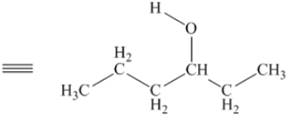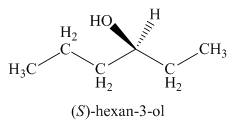
Concept explainers
(a)
Interpretation: The product formed by the treatment of given alcohol with
Concept introduction: The reaction of alcohols with halogen acids
Answer to Problem 9.37P
The products formed by the treatment of given alcohol with
Explanation of Solution
The given structure of alcohol is in the form of ball-and-stick model. It is converted into skeletal structure by replacing black ball with


Figure 1
The above skeletal structure indicates that the given alcohol is secondary. It contains only one stereogenic center at

Figure 2
The reaction of alcohols with halogen acids
Since the given alcohol is secondary, it follows
The

Figure 3
The products formed by the treatment of given alcohol with
(b)
Interpretation: The product formed by the treatment of given alcohol with
Concept introduction: Alkyl bromides are obtained by the reaction of
Answer to Problem 9.37P
The product formed by the treatment of given alcohol with
Explanation of Solution
Alkyl bromides are obtained by the reaction of
Since the given alcohol is secondary, it follows
The

Figure 4
The product formed by the treatment of given alcohol with
(c)
Interpretation: The product formed by the treatment of given alcohol with
Concept introduction: The reaction of alcohols with halogen acids
Answer to Problem 9.37P
The products formed by the treatment of given alcohol with
Explanation of Solution
The reaction of alcohols with halogen acids
Since the given alcohol is secondary, it follows
The

Figure 5
The products formed by the treatment of given alcohol with
(d)
Interpretation: The product formed by the treatment of given alcohol with
Concept introduction: Alkyl chlorides are obtained by the reaction of
Answer to Problem 9.37P
The product formed by the treatment of given alcohol with
Explanation of Solution
Alkyl chlorides are obtained by the reaction of
Since the given alcohol is secondary, it follows
The

Figure 6
The product formed by the treatment of given alcohol with
Want to see more full solutions like this?
Chapter 9 Solutions
Organic Chemistry
- Explain reasons as to why the amount of caffeine extracted from both a singular extraction (5ml Mountain Dew) and a multiple extraction (2 x 5.0ml Mountain Dew) were severely high when compared to coca-cola?arrow_forwardProtecting Groups and Carbonyls 6) The synthesis generates allethrolone that exhibits high insect toxicity but low mammalian toxicity. They are used in pet shampoo, human lice shampoo, and industrial sprays for insects and mosquitos. Propose detailed mechanistic steps to generate the allethrolone label the different types of reagents (Grignard, acid/base protonation, acid/base deprotonation, reduction, oxidation, witting, aldol condensation, Robinson annulation, etc.) III + VI HS HS H+ CH,CH,Li III I II IV CI + P(Ph)3 V ༼ Hint: no strong base added VI S VII IX HO VIII -MgBr HgCl2,HgO HO. isomerization aqeuous solution H,SO, ༽༽༤༽༽ X MeOH Hint: enhances selectivity for reaction at the S X ☑arrow_forwardDraw the complete mechanism for the acid-catalyzed hydration of this alkene. esc 田 Explanation Check 1 888 Q A slock Add/Remove step Q F4 F5 F6 A བྲA F7 $ % 5 @ 4 2 3 & 6 87 Click and drag to start drawing a structure. © 2025 McGraw Hill LLC. All Rights Reserved. Terms of Use | Privacy Ce W E R T Y U S D LL G H IK DD 요 F8 F9 F10 F1 * ( 8 9 0 O P J K L Z X C V B N M H He commandarrow_forward
- Explanation Check F1 H₂O H₂ Pd 1) MCPBA 2) H3O+ 1) Hg(OAc)2, H₂O 2) NaBH4 OH CI OH OH OH hydration halohydrin formation addition halogenation hydrogenation inhalation hydrogenation hydration ☐ halohydrin formation addition halogenation formation chelation hydrogenation halohydrin formation substitution hydration halogenation addition Ohalohydrin formation subtraction halogenation addition hydrogenation hydration F2 80 F3 σ F4 F5 F6 1 ! 2 # 3 $ 4 % 05 Q W & Å © 2025 McGraw Hill LLC. All Rights Reserved. F7 F8 ( 6 7 8 9 LU E R T Y U A F9arrow_forwardShow the mechanism steps to obtain the lowerenergy intermediate: *see imagearrow_forwardSoap is made by the previous reaction *see image. The main difference between one soap and another soap isthe length (number of carbons) of the carboxylic acid. However, if a soap irritates your skin, they mostlikely used too much lye.Detergents have the same chemical structure as soaps except for the functional group. Detergentshave sulfate (R-SO4H) and phosphate (R-PO4H2) functional groups. Draw the above carboxylic acidcarbon chain but as the two variants of detergents. *see imagearrow_forward
- Assign all the signals individually (please assign the red, green and blue)arrow_forwardThe two pKa values of oxalic acid are 1.25 and 3.81. Why are they not the same value? Show the protontransfer as part of your explanation. *see imagearrow_forwardасть Identify all the bonds that gauche interact with C-OMe in the most stable conformation of the above compound.arrow_forward
 Chemistry: Principles and ReactionsChemistryISBN:9781305079373Author:William L. Masterton, Cecile N. HurleyPublisher:Cengage Learning
Chemistry: Principles and ReactionsChemistryISBN:9781305079373Author:William L. Masterton, Cecile N. HurleyPublisher:Cengage Learning
